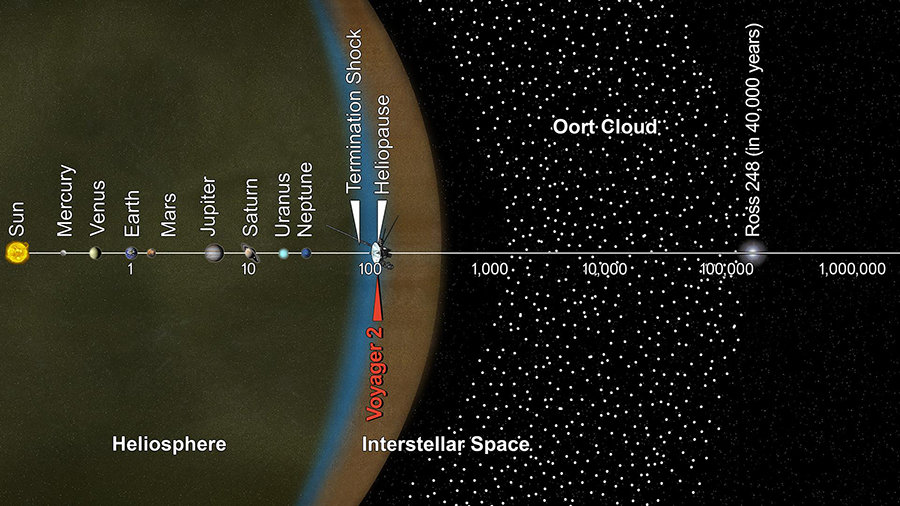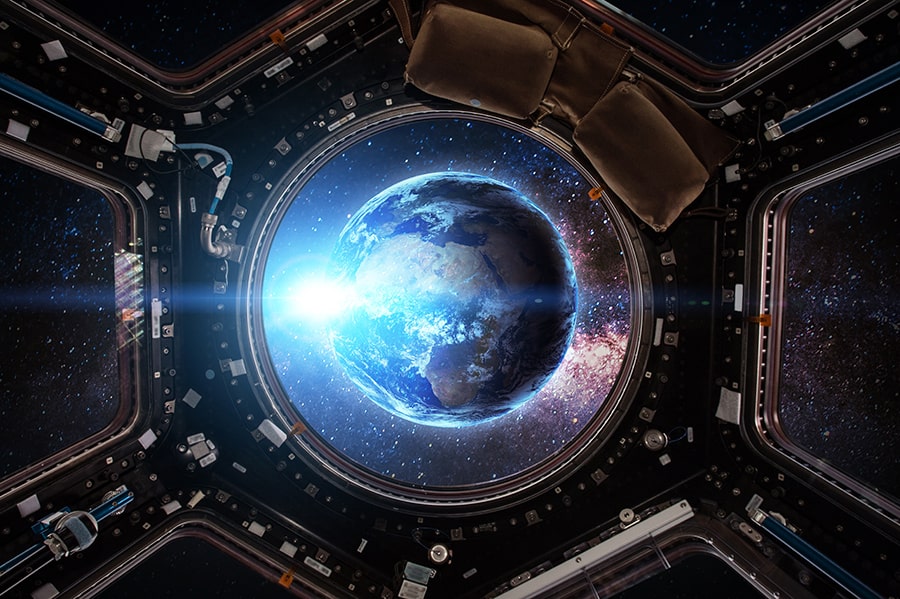Intergalactic travel is fascinating and sci-fi on steroids. So buckle up, as we dive into 6 thought-provoking questions on this wild topic.
Let’s be real, just getting to Mars is a huge challenge for us humans, and our solar system is just a speck compared to the vastness of our galaxy, the Milky Way. As the brilliant Douglas Adams once put it:
“Space is big. Really big. You just won’t believe how vastly, hugely, mind-bogglingly big it is.”
Just think about this: on August 20, 1977, NASA launched Voyager 2, which is still one of the fastest human-made objects ever created. It zips along at a jaw-dropping speed of 34,500 miles per hour.
The image below is an artistic rendition of Voyager 2’s distance traveled as of December 2018. The x-axis measures in Astronomical Units (AU), where 1 AU is the distance from the Sun to Earth, or about 93 million miles. The mind-boggling part? Voyager 2 still hasn’t left our solar system after 43 years of travel!

Now, keep that Voyager 2 image in your mind. We’re going to kick things up a notch and explore the intergalactic scale in the next section.
#1 What are the biggest challenges of intergalactic travel?

There’s no shortage of hurdles when it comes to intergalactic travel. Here’s a quick rundown:
- Insane distances between galaxies
- Spacecraft durability against the harsh elements of space
- Limited propulsion technology
- Not enough energy to travel crazy far distances
Of these challenges, the travel distance is probably the hardest to wrap our heads around. The table below lists some mind-bending distances to give you a sense of the scale we’re dealing with:
| Popular defined distances | Total distance |
|---|---|
| San Francisco to Los Angeles | 380 miles |
| New York to Paris | 3,628 miles |
| Earth diameter | 7,920 miles |
| Earth to Moon | 238,900 miles |
| Earth to Mars | 206,400,000 miles |
| Earth to Jupiter | 453,000,000 miles |
| Sun to Pluto | 3,670,000,000 miles |
| Solar system diameter | 178,600,000,000 miles |
| Earth to nearest star | 24,984,000,000,000 miles |
| Milky Way diameter | 621,300,000,000,000,000 miles |
| Milky Way to nearest galaxy | 14,690,000,000,000,000,000 miles |
Our primitive brains just can’t grasp these numbers. Even the distance to the Moon is enough to give us a headache. After all, we’re the same species that complains about a 250-mile drive to our favorite camping spot.
The energy needed for the trip is a bit easier to picture. But it’s not as simple as fueling up a spacecraft on Earth and blasting off into the cosmos. Let’s calculate the energy required to travel to Alpha Centauri, the nearest star to Earth, as an example.
Energy requirement calculation for a trip to Alpha Centauri
Alpha Centauri is about 4.24 light-years away from Earth. In our sci-fi scenario, let’s assume our spacecraft travels at sub-light speed, making the trip in 25 years.

Important Note: Voyager 2’s speed is 34,500 miles per hour, while the speed of light is 670,600,000 miles per hour. Our fastest human-made object travels at a measly 0.00514% of the speed of light.
At that rate, it would take Voyager 2 just under 85,000 years to reach Alpha Centauri!
[Latexpage]
First, let’s figure out the speed our rocket needs to travel to make the trip in 100 years.
Velocity = $\dfrac{\text{4.24 light-years}}{\text{100 years}}$ x $\dfrac{\text{9,500,000,000,000,000 meters}}{\text{1 light year}}$ x $\dfrac{\text{1 year}}{\text{31,540,000 seconds}}$ = 51,084,337 meters / second
Now, consider SpaceX’s Falcon Heavy, weighing in at a hefty 1,420,788 kilograms or 1,566 tons. Let’s assume our spacecraft heading to Alpha Centauri is at least 50 times as massive, especially if we’re bringing humans along for the ride. That gives us 1,566 tons x 50 = 78,300 tons.
$E_{k} = \dfrac{mc^{2}}{\surd[1-(v/c)^{2}]} – mc^{2}$
$E_{k} = \dfrac{(78,300)(300,000,000)^{2}}{\surd[1-((51,084,337)/(300,000,000))^{2}]} – (78,300)(300,000,000)^{2}$
= 1.04 x $10^{20}$ joules
Back in 2017, the entire world’s energy consumption was 585 x $10^{18}$ joules. Even if we used every last drop of that energy in a year, we’d still be nowhere near reaching Alpha Centauri in 25 years. Mind-blowing, huh?!

Important Note: Rockets that need propellant to accelerate aren’t efficient. Your acceleration, $\vartrianglev$, depends on how much propellant your spacecraft can lug around. And guess what? The more $\vartrianglev$ you want, the more exponentially your propellant mass grows.
Our current chemical and ion engines just won’t cut it for galactic road trips. The amount of propellant needed would be way heavier than the spacecraft itself, and we’d be stuck traveling for thousands of extra years.
Think about it: today’s space rockets burn through their fuel in minutes. But to hit those crazy high speeds, we’d need enough fuel to burn for years on end. Plus, the energy from that $\vartrianglev$ would be out-of-this-world intense inside the spacecraft.
#2 Why even travel beyond the Milky Way to new galaxies?
Christopher Columbus once said,
“You can never cross the ocean unless you have the courage to lose sight of the shore.”
That urge to explore is in our blood. We’re natural-born adventurers, and that’s not changing anytime soon. But besides just exploring, there are other reasons to pack our bags for intergalactic travel:
- The Sun running out of hydrogen fuel and making the earth inhabitable
- Resource gathering
- Hedging against a potential doomsday on Earth (e.g. asteroid impact)
- Discovering alien life
I know how farfetched intergalactic travel may sound, but those who quickly dismiss the pursuit only need to flip through history. Hundreds of millions of years ago, sea organisms looked at dry land in awe. I bet the idea of living on land seemed impossible then, just like deep space travel does now.
And hey, even intelligent machines would share our reasons for intergalactic travel. In fact, they have even more reason to look beyond Earth. Why would a machine made of nuts and bolts stay in a corroding environment on Earth?…
#3 What type of spacecraft would make intergalactic travel possible?
Picture this: a spacecraft that can withstand the brutal conditions of outer space, zipping through the cosmos at mind-blowing speeds. Sounds like a dream, right? Well, the key to making this dream a reality lies in developing a propulsion system that can really pack a punch. Today’s technology has its limitations, but here are some exciting ideas scientists have proposed for the future:
Antimatter rocket
Think of antimatter as rocket fuel on steroids. According to NASA,
“While tons of chemical fuel are needed to propel a human mission to Mars, just tens of milligrams of antimatter will do (a milligram is about one-thousandth the weight of a piece of the original M&M candy).”
So, what’s stopping us from using this incredible fuel right now? Firstly, it’s insanely expensive and scarce. You won’t find antimatter mines nestled in mountain ranges, that’s for sure.
Secondly, when matter and antimatter react, they generate a bunch of destructive high-energy particles. These particles not only wreak havoc on the crew and equipment but are also difficult to control. This means you can’t just use the released energy to steer your exhaust. And if that wasn’t enough, storing antimatter demands massive magnetic fields.
Bussard Ramjet
Imagine using the ionized hydrogen found in space for thrust. Picture a magnetic scoop made of electromagnetic fields that gathers ionized hydrogen. A nuclear fusion reactor would then consume the hydrogen to power a spacecraft, meaning the ship wouldn’t have to lug reactant mass from Earth.
This could be a game-changer since it would significantly reduce a spacecraft’s total mass. However, it comes with its own set of engineering challenges.
The hydrogen collector would have to be ginormous to capture enough hydrogen. But even then, the magnetic scoop could theoretically create drag, possibly negating any generated thrust. And who knows how much hydrogen is actually floating around between galaxies?
Solar Sail
A solar sail is an attractive option because you don’t need to carry your reaction mass with you. Like the Bussard Ramjet, you’d collect it from space, utilizing the radiation from stars for propulsion. The spacecraft’s reflective sails would capture light’s momentum, propelling it forward.
The catch? The sails would have to be miles wide. While this idea might work wonders for interstellar travel, intergalactic travel is a different story. In the vast emptiness of space, stars would be mere specks in the distance.
Nuclear Pulse
Imagine detonating nuclear pellets behind a spacecraft, propelling it forward with each explosion. Sounds thrilling, right?
The downside is the sheer number of nuclear “bombs” your spacecraft would need to carry on board. The weight required to achieve the desired $\vartrianglev$ would be colossal.
By now, you’ve probably noticed the common theme among these propulsion options: reaction mass is the limiting factor. So, the logical approach is to create a reactionless drive, eliminating the need to exchange momentum with a reaction mass to accelerate your spacecraft.

Important Note: Hitting the brakes is just as tricky as speeding up when you’re zipping around at sub-light speeds. Slowing down as you approach your destination is a challenge all on its own.
Oh, and don’t forget about space dust and atoms. Contrary to popular belief, the space between stars and galaxies isn’t totally empty. Tiny dust particles and atoms are scattered everywhere. When these little guys smack into a spacecraft, they cause local heating, which can lead to evaporation and altered material properties.
Those bigger dust particles? They can straight-up annihilate a spacecraft. To dodge this cosmic dust storm, we’ll need some seriously advanced energy shields and a sleek, slimmed-down spacecraft to minimize the exposed surface area.
#4 Is intergalactic travel possible for humans?

As for us humans, well, we’re basically just bags of meat, so the journey isn’t exactly practical. But hey, never say never, right? If we ever make that trip, we’ll probably look nothing like we do today.
We might rework our DNA and ditch a lot of what makes us human – our meaty bodies, reproductive organs, physical senses, and all that jazz. Only then might we have a glimmer of hope for intergalactic travel.
Honestly, it’s not too far-fetched. Just a century ago, who would’ve guessed we’d have the world’s info in our back pockets? The same goes for human biological progression. We’re becoming more machine-like every year, boosting our intelligence and physical abilities.
So, while I can’t picture intergalactic travel with our current human biology, the future might be a whole different ball game. Technology is rapidly outpacing the slow crawl of biological evolution.
#5 Is intergalactic travel possible for machines?
The big edge we humans have over machines is versatility. But looking far into the future, machines could very well match – and surpass – our versatility without the hefty price tag of keeping a human alive in space. Even a cyborg, half human half machine, would be costly.
Machines have a much better shot at making this seemingly impossible trip. And honestly, it doesn’t sound all that far-fetched when compared to a human journey. Just picture a future with Artificial Super Intelligence (ASI) calling the shots. These ASIs could make decisions in real time without any pesky biological limitations.
Plus, communication signals take ages to travel across vast distances. For our neighbor, Mars, radio signals take 5 to 20 minutes. But ASI wouldn’t need to chat with Earth to make the trip a success.
#6 How will advanced physics and technology affect the pursuit of intergalactic travel?
As we unravel the mysteries of physics, our hunger for space travel will only grow. We’ll discover mind-blowing things about how the universe works, fueling our curiosity about what lies beyond our solar system.
But just to play devil’s advocate, maybe exploration will lose its appeal once we reach a certain level of intelligence. We might be able to ditch the physical world and live in a fully digital one where we can do anything we want.
This digital world could be teeny-tiny, like the size of a strawberry. So why bother with risky, resource-intensive explorations?…

Important Note: Our current understanding of physics clashes with the idea of successful intergalactic travel. We’re still learning how physics really works in the grand scheme of the universe.
Our grasp of physics has evolved tremendously in just a few centuries. So who knows what we’ll learn in the next 1,000 years, let alone 10 million?
Conclusion
Intergalactic travel feels like something out of a wild sci-fi movie. Even Star Trek steered clear of these insane distances, keeping their ships within one galaxy. But what happens when our understanding of the universe leaps forward?
Stephen Hawking once famously said,
“I don’t think the human race will survive the next 1,000 years, unless we spread into space. There are too many accidents that can befall life on a single planet. But I’m an optimist. We will reach out to the stars.”
This thought keeps me tossing and turning at night, y’know? Intergalactic travel is both absolutely captivating and makes my brain hurt just thinking about it. At the same time, the cosmos is the ultimate way to keep yourself grounded. I believe this with all my heart. Nothing else can even come close to stirring up the same feelings inside me.
Sure, I know that intergalactic travel might be millions of years away, if I’m being optimistic. I mean, just getting to the nearest star feels like climbing Mount Everest blindfolded. But who knows, maybe some far-out sci-fi idea will one day become reality. Warp drives, teleportation…hey, we’re allowed to dream, right?
Do you think intergalactic travel is ever possible for us humans? What gets you all fired up about intergalactic travel? What do you reckon is the biggest challenge with this mind-bending adventure?
